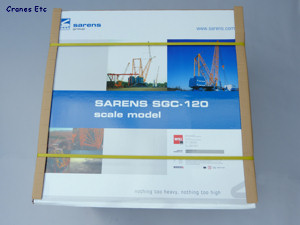 |
| Inside each of
the two massive cartons is a sleeved box. |
 |
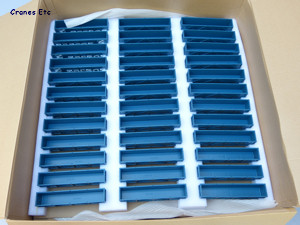 |
| Middle layer -
Carton 1. |
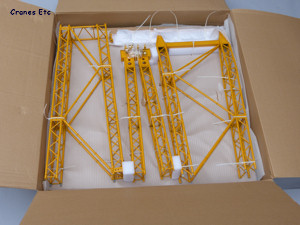 |
| Top layer - Carton
2. |
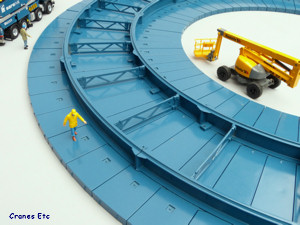 |
| The ring plates
are individual pieces. |
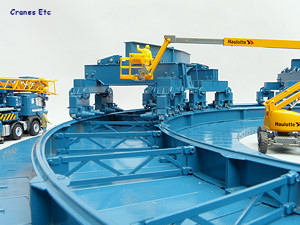 |
| A
Haulotte HA20
PX assists in attending to one of the bogies. |
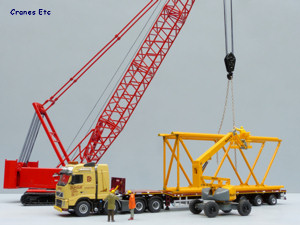 |
| A
Manitowoc 555
dreams of lifting a boom section off a
Nooteboom trailer.
|
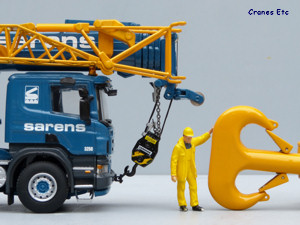 |
| Just compare.
|
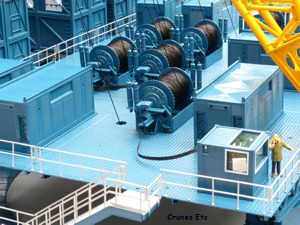 |
| Upper deck is
clean and tidy. |
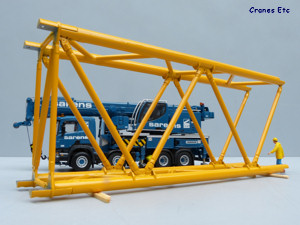 |
| Boom section compared
to a truck crane. |
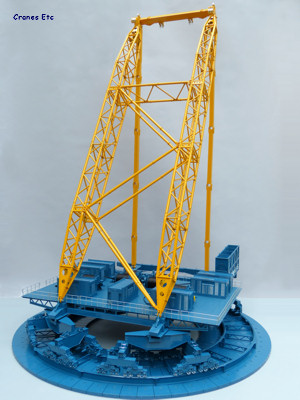 |
| The A frame mounted.
|
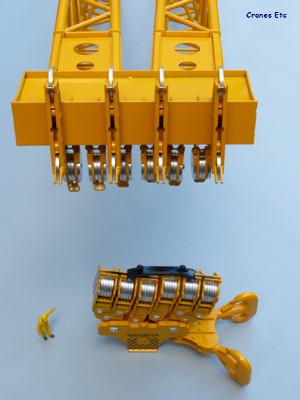 |
| Ready for reeving
up. It could be a long night. |
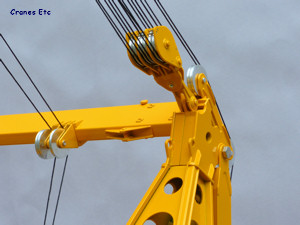 |
| Large metal
pulleys on the A-frame. |
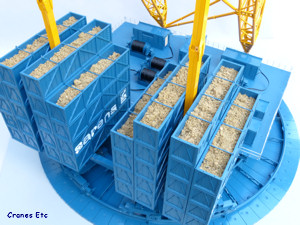 |
| Loaded containers
all on board. |
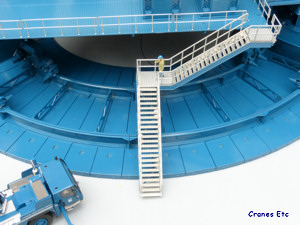 |
| Detailed
access stairs. |
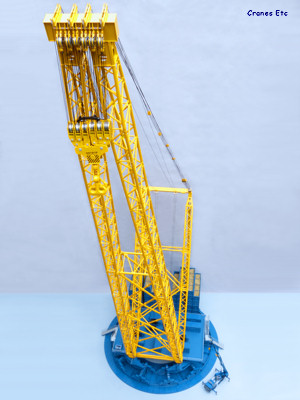 |
| A massive
crane model. |
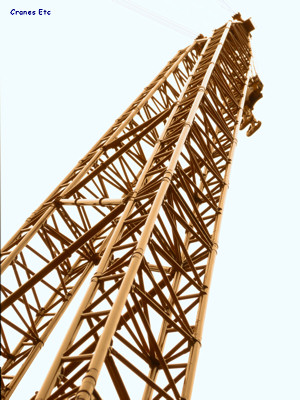 |
| Impressive
heavy boom. |
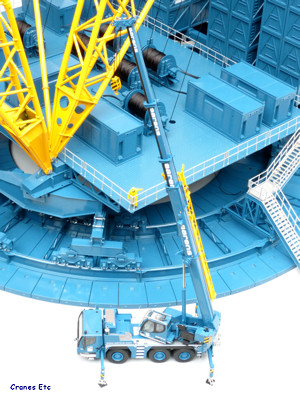 |
| A Liebherr LTM
1050-3.1 is somewhat overwhelmed. |
|
The Sarens SGC-120 is a giant ring crane
with a lifting capacity of 3200 tonnes. It has been
designed for use in petrochemical, nuclear and other engineering
activities where heavy lifting is the requirement.
It can lift 3200t at 30m radius and 1000t at 80m.
The real crane has a 130m main boom and a 90m light duty
jib can be fitted.
Among the interesting statistics for this crane is the weight
of the hook block at 105 tonnes and the ballast is provided
by locally sourced material in 36 40ft shipping containers
to produce 3600t of ballast. The entire crane can
be shipped in around 135 standard containers. It takes
one hour for the crane to rotate through one revolution.
This scale model is enormous. It is configured with
the main boom only but laid out the overall length of the
model is 3.3m long. With the boom up it reaches 2.6m
and the diameter of the ring to the edge of the spreaders
is nearly 90cm.
Packaging
The model comes in two very large cartons measuring 92x91x29cm
and weighing approximately 26 and 22kg. Each contains
another box with a colourful Sarens sleeve on the outside.
Because of the size the sleeve is most easily cut off rather
than trying to push the inner box out.
Inside the boxes the model parts are packed in layers with
the boom sections tied to cardboard bases. This works
well in terms of protecting the parts (particularly as the
outer boxes had some shipping damage), but if you want to
keep the ties for re-use in packing the model it is a painstaking
exercise to release them and free the parts.
There were no defects or missing parts other than one container
cross-tie which had not been cast properly but this was very minor
and was to be replaced by WSI.
There were no instructions included in the box, and these
were supplied separately, and are also available for
download. The instructions are clear and good with only
the main reeving diagram having some small conflicts.
The two bolts that secure the main boom are a little too
short to tighten the nuts properly but this is not a problem
as the bolts are very unlikely to move.
There is is no information about the real SGC-120 which
is an opportunity missed, and a uniquely numbered collector's
card would have given a special feeling.
Unpacking and assembly is not difficult although some operations really
need two people at least and a day should be set aside. Reeving the hook and luffing
winches is time consuming and requires considerable patience
and a calm temperament.
One interesting aspect is that the model
does not come with loaded ballast. Instead the containers
are empty and need to be filled with sand or other material.
This is a sensible modelling decision by WSI as it reduces
the shipping weight while at the same time reflecting the
philosophy of the real crane.
Detail
An interesting aspect of the model is that much of it is
preassembled. The ring with the ground bearing plates
is all prefabricated in the box and accounts for the packaging
size. However closer inspection suggests it can be
split into smaller appropriate pieces by undoing screws.
The ring is all metal and includes detailed lattice sections.
Four bogies are mounted on the ring track, two at the front
(with more rollers) and two at the back. These are very
large pieces with suitably strong metal beams. Unlike
much of the model there are some riveted connections
so it is not so easy to break the bogies down into transport
loads. Each roller has a plastic motor modelled although there
are no cables running to the plastic control frame.
The upper structure is very big, but simple in design
and detail as it reflects the uncomplicated design of the
real crane. The structure looks great with realistic
beams and the deck surface has an anti-slip surface.
Six large detailed winches are mounted on the deck together
with seven metal containers, and there are hydraulic lines
running between them. The handrails are metal and
there are two sets of excellent metal staircases to provide
access to the deck. There is nothing by way of graphics
around the deck area and the two holes in the deck for the
luffing rope equaliser look odd without some protection
or guarding around them. Underneath the deck there
are two pulleys which are used for the luffing rope equaliser.
These are plastic non-functioning parts which although they
will be rarely seen is something of a modelling compromise,
and they did not seem to properly align on the review
model.
A small plastic cabin provides the operator's area.
It is well detailed inside with controls, screen, cabinet
and seat and it would have been nice if it had lifting eyes
so it could be posed being lifted. Such is the size
of the crane that the cabin looks lost on the massive machine
deck.
At the rear of the upper deck there are 36 ballast containers.
These are made of tough plastic which is the right material
given that they get filled with sand or stones and fortunately
they have a very good colour match. Metal cross ties
add strength and allow good stacking although as provided
the containers cannot be posed being lifted by a crane unless
the cross ties are glued in. Four of the containers
are emblazoned with the Sarens name.
The main A frame is made of huge parts. The rear
ties are about 20cm square and are heavy. The main
struts are giant lattice sections 10cm x 5cm at the widest
with member sizes around 8mm thick. This is massive
size model engineering and is very impressive on its own.
At the top of the A-frame are large silver metal pulleys
for the hook and boom luffing ropes.
The boom sections are the same dimensions as the A-frame
parts and the whole boom is therefore massive, well made
and strong. It consists of small discrete sections
which are screwed together and the structure of each is
very good with all lattice chord members tubular in
section. At the boom head are large banks of pulleys
for the hook
ropes.
The main boom guy ropes have metal connectors and look good
with good manufacture meaning that the tensions in the parts
look broadly equal with nothing sagging.
The hook block is very large and heavy, and includes a huge
pair of double hooks with latches. It is very well
detailed with excellent graphics and this makes a
great model on its own.
Features
The real SGC-120 is designed to be broken down into container
loads and many of the models components can also be
broken down to smaller pieces with the main exceptions being
the hook block, bogies and upper deck plate
The upper deck sits on the bogies and rotates smoothly even
though the model is exceptionally heavy.
The main block is controlled by four winches and these work
really well with a smooth push-release brake.
However it is difficult to raise and lower the hook
using the winches without the tension being lost in some
of the ropes which allows them to jump off the pulleys. The
design of the hook block is such that it does not appear
to be easily broken down into smaller hook blocks so different
rigging options are unavailable. However the hook
block does have working spring-loaded latches which is a
nice touch.
Luffing of the boom is controlled by two winches of the
same design as the hoist winches. However there appears
to be friction in the mechanism as raising and lowering
the boom does not work well using the winches and the
fixed plastic
pulleys under the deck probably do not help with equalising
either. WSI acknowledge this by recommending the luffing
gear is reeved with the boom at the desired angle.
Quality
WSI has produced a very large model with some remarkable
engineering given the forces that apply in something so
big. It is well made. There is some plastic which
is used appropriately and the paint and finish is very
good.
Price
In 2012 this is the largest 1:50 scale crane model available
and there is a great deal of metal for the money, and
some of the pieces are of extraordinary size. On this
basis it is good value for the size offered.
Overall
As a model engineering achievement the Sarens SGC-120 ring
crane sets the bar higher. It is a giant of a model
and will get attention from anyone who sees it. Of
course a collector needs a big wallet and a lot of space
to display it properly. It would look great in an
office, particularly as part of a scene where it is lifting
a heavy element.
It is not the most highly detailed model though. The
real crane is a simple and efficient design and the model
captures that perfectly but at close viewing there are few
graphics or details such as cables and hoses.
Overall it is a great model of the real crane, and a
great model because it just towers over everything and is
certainly outstanding.
Footnotes
The model first appeared at the Nuremberg Toy Fair in 2012
and shipments commenced in June 2012. It was produced
in a run of 500 models.
|
|
|
|
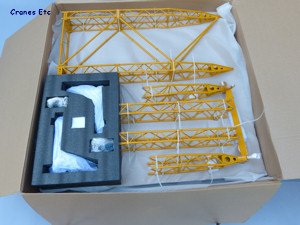 |
| Top layer - Carton
1. |
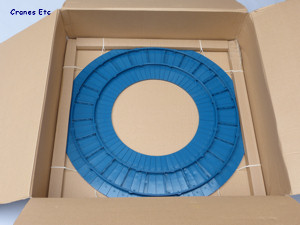 |
| Bottom layer -
Carton 1. |
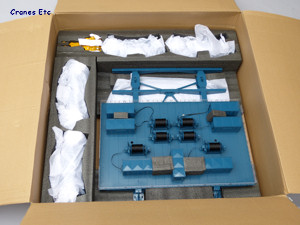 |
| Bottom layer -
Carton 2. |
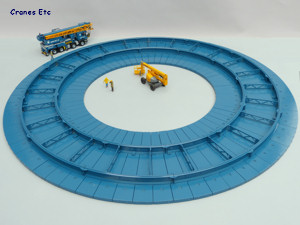 |
| The ring sitting
on the load spreaders. The Cranes Etc team members are
arguing how they left the Haulotte inside the ring. |
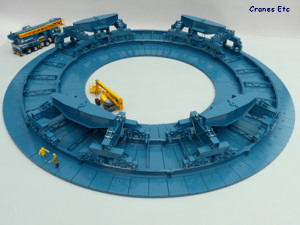 |
| Four bogies on
the track. |
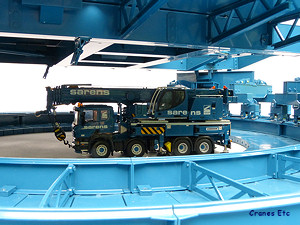 |
| With the upper
deck on it towers over Liebherr LTF 1060 mobile crane.
Please don't ask why the Cranes Etc riggers left the crane
in there. |
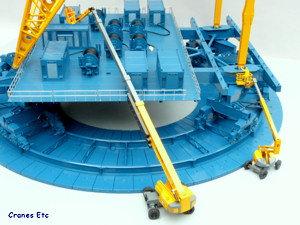 |
| The Cranes Etc
riggers using powered access. |
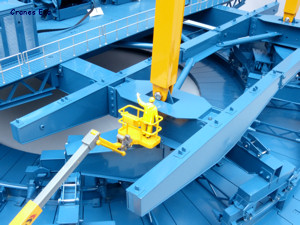 |
| Massive steelwork.
|
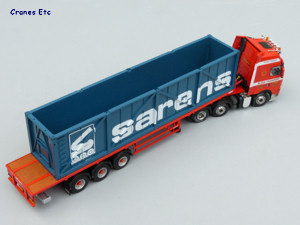 |
| One of the containers
loaded on a flatbed truck.
|
 |
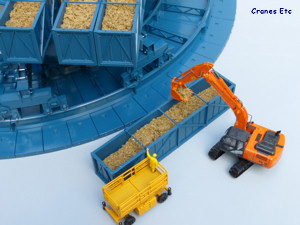 |
|
Hitachi
ZX 210 loading a container with local materials.
|
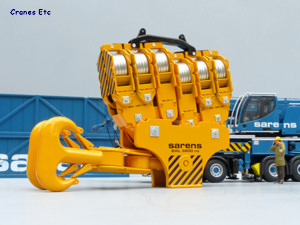 |
| Yes, it is 'supersize'.
|
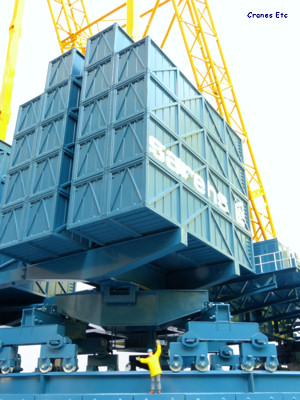 |
| The scale of the
crane becomes apparent. |
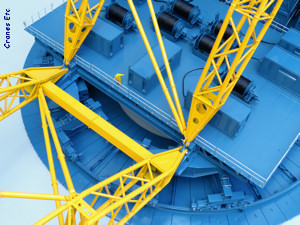 |
| Spot the
worker.
|
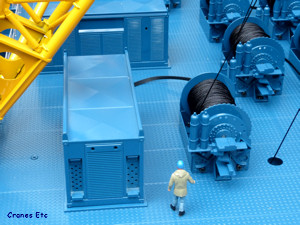 |
| Large winches
and containers.
|
 |
| Boom-head eye
view. |
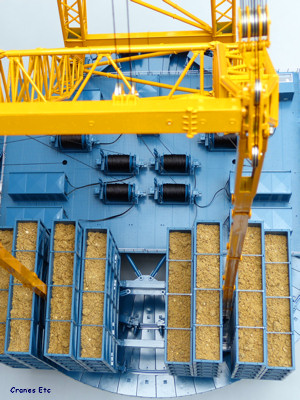 |
| Massive ballast. |
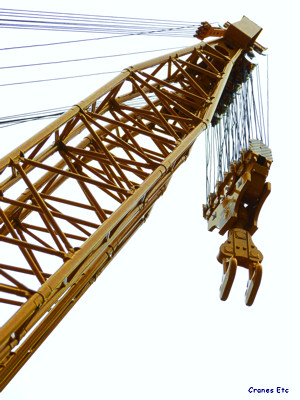 |
| Most cranes
could not even lift the hook. |
 |
|

